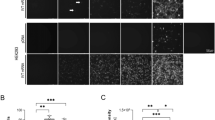Abstract
The acute phase reaction of rat liver to subcutaneous turpentine challenge results in a 20- to 100-fold increase in α1-acid glycoprotein (αAGP) mRNA. We utilized this response to establish conditions appropriate for study of RNA transport in vitro using hybridization with 32P-labeled exon and intron αAGP sequences. Contamination of nuclear preparations by membrane-absorbed cytoplasmic RNA was eliminated by detergent-rinsing. The in vitro incubation conditions that most reflected the in vivo state required RNase inhibitor (purified from placenta), polyvinylpyrrolidone to prevent nuclear swelling, and addition of ATP. Under these circumstances, αAGP sequences were transported only from turpentine-stimulated preparations, were found only in poly(A) + RNA, and were the same size as authentic cytoplasmic mRNA. Omission of polyvinylpyrrolidone resulted in release of some αAGP sequences in smaller, more heterogeneous poly(A)-RNA, and leakage of some αAGP sequences was observed from control preparations. Omission of ATP resulted in restriction of mature αAGP mRNA to the nucleus. In contrast to αAGP mRNA, transport of albumin mRNA was decreased 3-4X in turpentine-treated preparations. The largest αAGP intron was not found in RNA transported from treated nuclei in complete medium. The intron-containing fragments remained in the nucleus, largely in poly(A)- RNA of a size consistent with free intron. Some hybridization of intron sequences was observed with cytoplasmic and nuclear membrane-associated poly(A) + RNA preparations which may represent 3′-processing catabolites; leakage of these sequences was considerably greater in the absence of PVP. On the basis of densitometric estimates, a 5-fold increase in the amount of αAGP exon sequences was observed in nuclear RNA, comparing treated with control animals, but transport of αAGP exon sequences was detectable only from treated nuclei, indicating at least a 50-fold increase in abundance of αAGP sequences. This suggests that a selective gating mechanism may be operative at the level of post-transcriptional nucleocytoplasmic transport during induction of αAGP in the acute phase response.
Similar content being viewed by others
Abbreviations
- αAGP:
-
α1-acid glycoprotein
- PVP:
-
polyvinylpyrrolidone
- SSC:
-
standard saline citrate
References
GeorgievO., MousJ. & BirnstielM., 1984. Nucl. Acids Res. 12: 8539–8551.
SchneiderJ., 1959. J. Biol. Chem. 234: 2728–2732.
IshikawaK., KurodaC. & OgataK., 1970. Biochim. Biophys. Acta 213: 505–512.
BagliaF. & MaulG., 1983. Proc. Natl. Acad. Sci. (USA) 80: 2285–2289.
Kindas-MuggeI. & SauermanG., 1985. Eur. J. Biochem. 148: 49–54.
ClawsonG., KoplitzM., Castler-SchechterB. & SmucklerE., 1978. Biochemistry 17: 3747–3752.
ClawsonG. & SmucklerE., 1978. Proc. Natl. Acad. Sci. (USA) 75: 5400–5404.
OteguiC. & PattersonR. J., 1981. Nucl. Acids Res. 9: 4767–4781.
RaskasH., 1971. Nature New Biol. 233: 134–136.
SchummD. & WebbT., 1978. J. Biol. Chem. 253: 8513–8517.
AgutterP., McCaldinB., & McArdleH., 1979. Biochem. J. 182: 811–819.
ClawsonG., JamesJ., WooC., FriendD., MoodyD. & SmucklerE., 1980. Biochemistry 19: 2748–2756.
ClawsonG., MoodyD., FerrellL. & SmucklerE., 1984. Lab. Invest. 51: 682–689.
MurtyC., HornsethR., VerneyE. & SidranskyH., 1983. Lab. Invest. 48: 256–262.
PurrelloF., VigneriR., ClawsonG. & GoldfineI., 1982. Science 216: 1005–1007.
BaumannH., FirestoneG., BurgessT., GrossK., YamamotoK. & HeldW., 1983. J. Biol. Chem. 258: 563–570.
KojA., 1974. In A.Allison (ed.), Structure and function of plasma proteins, vol. 1, Plenum Publishing Co., London. pp 73–131.
RiccaG., HamiltonR., McLeanJ., ConnA., KalinyakJ. & TaylorJ., 1981. J. Biol. Chem. 256: 10362–10368.
BlobelG. & PotterV., 1966. Science 154: 1662–1665.
ChauveauJ., MouleY. & RouillerC., 1956. Exp. Cell Res. 11: 317–321.
JacobsH. & BirnieG., 1982. Eur. J. Biochem. 121: 597–607.
BlackburnP., 1979. J. Biol. Chem. 254: 12484–12487.
BergerS. & BirkermeierC., 1979. Biochemistry 18: 5143–5149.
KrainerA., ManiatisT., RuskinB. & GreenM., 1984. Cell 36: 993–1005.
ClawsonG., ButtonJ., WooC. & SmucklerE., 1985. Molec. Biol. Rpts. 10: 105–107.
ChirgwinJ., PrzybylaA., MacDonaldR. & RutterW., 1975. Biochemistry 18: 5294–5299.
WhiteB. & BancroftF., 1982. J. Biol. Chem. 257: 8569–8572.
GlisinV., CrkvenjakovR. & ByusC., 1974. Biochemistry 13: 2633–2637.
AvivH. & LederP., 1972. Proc. Natl. Acad. Sci. (USA) 69: 1408–1412.
ManiatisT., FritschE. & SambrookJ., 1983. Molecular Cloning, a Laboratory Manual. Cold Spring Harbor Press, New York.
ThomasP., 1980. Proc. Natl. Acad. Sci. (USA) 77: 5201–5205.
LaemmliU., 1970. Nature (London) 227: 680–685.
RiccaG. & TaylorJ., 1981. J. Biol. Chem. 256: 11199–11202.
SargentT., YangM. & BonnerJ., 1981. Proc. Natl. Acad. Sci. (USA) 78: 243–246.
Liao, Y., Taylor, J., Vannice, J., Clawson, G. & Smuckler, E., 1985. Mol. Cell. Biol. (in press).
VanniceJ., RingoldG., McLeanJ. & TaylorJ., 1983. DNA 2: 205–212.
AndersonK., MartinA. & HeathE., 1984. Arch. Biochem. Biophys. 233: 624–635.
RosenthalR. & RaskasH., 1985. Mol. Cell. Biol. 5: 1084–1092.
AndersonN., 1953. Science 117: 517–519.
MacGregorH., 1962. Exp. Cell Res. 26: 520–525.
MerriamR. & HillR., 1976. J. Cell Biol. 69: 659–668.
HerlanG., GieseG. & WunderlichF., 1980. Biochemistry 19: 3960–3966.
PrincenJ., NieuwenhuizenW., Mol-BackG. & YapS., 1981. Biochem. Biophys. Res. Commun. 102: 717–723.
PattersonR., FetherstonJ., DenomeR. & WernerE., 1985. In: E.Smuckler and G.Glawson (ed.), Nuclear envelope structure and RNA maturation, UCLA symposia of molecular and cellular biology, vol. 26. Alan R. Liss, New York (in press).
ColecloughC. & WoodD., 1984. Mol. Cell Biol. 4: 2017–2022.
HatzoglouM., SekerisC. & HansonR., 1985. Proc. Natl. Acad. Sci. (USA) 82: 4346–4350.
Author information
Authors and Affiliations
Rights and permissions
About this article
Cite this article
Clawson, G.A., Button, J., Woo, C.H. et al. In vitro release of α1-acid glycoprotein RNA sequences shows fidelity with the acute phase response in vivo . Mol Biol Rep 11, 163–172 (1986). https://doi.org/10.1007/BF00419737
Received:
Revised:
Issue Date:
DOI: https://doi.org/10.1007/BF00419737




